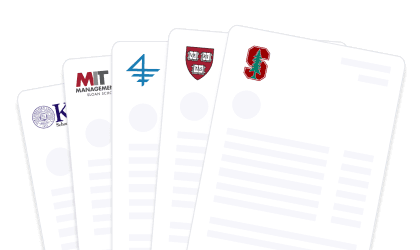MIT Sloan MBA Interview: Format, Expert Tips, & Common Questions
Get ready to ace your MIT Sloan MBA interview with our comprehensive guide! From an overview of the process to common questions and expert tips, this article has everything you need to impress the admissions committee and secure your spot at one of the top business schools in the world.
Posted June 13, 2025

Join a free event
Learn from top coaches and industry experts in live, interactive sessions you can join for free.
Table of Contents
If you’ve been invited to interview with MIT Sloan, congratulations! That means you're in serious contention for one of the most rigorous and innovation-driven MBA programs in the world. But the interview is not just a formality. At Sloan, it’s one of the most decisive components of the admissions process. And it’s unlike any other top MBA interview.
Here’s exactly what you need to know, and do, to stand out, with tips and tricks from expert MIT Sloan MBA coaches with years of experience helping applicants get into this M7 business school.
The MIT Sloan MBA Interview
Format
- Type: Not blind, they’ve read through your entire application
- Style: Behavioral event-based, structured
- Interviewer: MIT Sloan admissions staff
- Length: Typically ~30 minutes
- Format: Virtual
- Preparation Required: Upload your resume and submit 2 short-answer responses (within 24 hours of interview request)
Sloan Pre-Interview Questions
Question 1: The mission of the MIT Sloan School of Management is to develop principled, innovative leaders who improve the world and generate ideas that advance management practices. Graduates are expected to lead in a global and diverse environment, with the ability to navigate and manage diversity across roles, industries, identities, and perspectives. In 250 words or less, please describe a time when you contributed toward making a work environment or organization more welcoming, inclusive, and diverse.
Question 2: We are interested in learning more about how you use data to make decisions and analyze results. Please select one of the following prompts to respond to.
- Please select an existing data visualization and in 250 words or less explain why it matters to you. The data visualization should be uploaded as a PDF. Examples may come from current events, a business analysis, or personal research.
- In 250 words or less, please describe a recent data driven decision you had to make, and include one slide presenting your analysis. The slide may include a data visualization example and should present data used in a professional context. Your slide must be uploaded as a PDF.
What Makes the MIT Sloan MBA Interview Unique?
MIT Sloan’s interview is behavioral, structured, and conducted by an admissions committee member (not an alum). It’s designed to evaluate not only what you’ve done, but how you think, how you lead, and whether you embody the core values of Sloan: collaboration, intellectual curiosity, and principled leadership.
Here are a few other things that makes the interview unique:
- The interview is behavioral event-based. You’ll be asked to describe very specific past actions, not hypotheticals or broad summaries. Think “Tell me about a time when…” with lots of probing follow-ups.
- It’s conducted by an admissions officer. In other words, it isn’t an alumni coffee chat. Your interviewer is trained and calibrated to evaluate every answer through Sloan’s leadership model.
- It’s not blind but resume-forward. You’ll submit an updated resume and answer two short-answer prompts (within 24 hours of your interview). These set the tone and are used to customize your interview questions.
- It’s shorter and more intense. Most interviews last 30 minutes, one of the shortest of the top MBA programs. Expect ~5-8 deep-dive questions, not 15 surface-level ones.

Common MIT Sloan Interview Questions (& How to Answer Them)
Why MIT Sloan?
This isn’t just about showing you’ve researched the program, it’s about proving that Sloan is the only place where your goals, values, and learning style truly align. The best answers go beyond surface-level programs or rankings and instead highlight specific intersections between Sloan’s resources (like Action Learning Labs or the E&I Track) and your personal ambitions. Bonus points if you reference firsthand insights from students or alumni that genuinely shaped your perspective.
How to prepare: Make a short list of specific Sloan experiences, programs, or communities that you’re excited about – then ask why. What personal or professional need does each one solve? Next, write down 2-3 insights from real Sloan conversations (students, alumni, coaches) and what they taught you that you couldn’t learn online. Your answer should feel un-copyable.
Why an MBA?
MIT Sloan wants to know that you’re not applying reactively, but strategically. Your answer should show a clear career inflection point, the skill gaps you’re solving for, and why now is the right time. Great candidates also connect their “why MBA” answer to Sloan’s model of principled, data-driven, and collaborative leadership, demonstrating they understand how this MBA will help them grow, not just where it will take them.
How to prepare: Create a simple timeline: past roles → current pivot point → future goal. Identify the 2-3 most important skills, experiences, or networks you don’t yet have, and tie each one to something a top MBA (and Sloan specifically) offers. Don’t forget to reflect on why now is the right moment personally and professionally.
Tell me about [X experience].
Your resume will likely anchor part of your interview, so expect your interviewer to zoom in on a specific bullet or story, and ask you to walk them through what you actually did. Use this moment to break down the challenge, your decision-making process, and what impact you drove. Sloan interviewers are looking for clarity, ownership, and humility so speak confidently, but with precision and honesty. If it was a team effort, make your role unmistakably clear.
How to prepare: Go line by line through your resume and ask yourself: “What story does this tell?” Choose 2-3 bullets that reflect initiative, influence, or innovation. Then map out the STAR (Situation, Task, Action, Result) for each – and be ready to dive into specifics (metrics, stakeholders, decisions, follow-up). Practice saying it aloud until it sounds sharp but unscripted.
Tell me about a time when…
This is where Sloan’s behavioral approach shines: they want evidence of how you’ve handled real situations involving leadership, failure, conflict, feedback, or ambiguity. Don’t reach for a generic win; pick a situation that challenged you and revealed something about your character. Then show them how you think, not just what you did. Interviewers care just as much about your reflection as they do your result. If you can tie what you learned to how you lead differently today, you’ll stand out.
How to prepare: Brainstorm 4-5 stories that involve real stakes (emotionally, reputationally, or professionally). For each, ask: What did I learn? How did it change how I operate today? Practice articulating both the action and the reflection – that’s what sets strong answers apart. As a bonus, try repurposing the same story for multiple prompts by reframing the angle.
Expert Tip: MIT Sloan interviewers are known for asking follow-ups to your answers – not to trip you up, but to understand how you think, why you made certain choices, and what you’ve learned. Be ready to go several layers beyond your surface story. Think: What was I feeling? What was at stake? What would I do differently now?
What to Ask Your MIT Sloan Interviewer
The questions you ask at the end of your Sloan interview are more important than most applicants realize. They’re not just a formality, they’re a reflection of your curiosity, your preparation, and how you think. Great questions show that you’ve engaged deeply with the program, understand Sloan’s values, and are already thinking like a future contributor to the community. Remember that MIT Sloan interviewers are usually admissions officers, so they have heard hundreds of generic questions. To stand out, yours should feel thoughtful, specific, and rooted in your goals and interests.
How to Brainstorm Questions
Start by asking yourself:
- What do I still genuinely want to understand about Sloan beyond the website?
- Where do my goals or values intersect with something unique about Sloan (e.g. Action Learning, tech-forward leadership, principled innovation)?
- What part of the Sloan culture or academic approach do I want to explore further?
Then, write 3-5 questions that only apply to Sloan, show that you’ve done real homework, and open the door to a thoughtful conversation (i.e. they’re not a yes/no answer).
Example Questions
- How does Sloan’s culture of “learning by doing” show up in the classroom and beyond? What have you seen in terms of how students navigate ambiguity or failure during those experiences?
- In your experience, what distinguishes applicants who thrive at Sloan from those who struggle to adapt?
- How does Sloan balance its data-driven decision-making approach with the softer side of leadership like communication, empathy, and inclusion?
- What kinds of conversations or debates do you see happening most often among students right now? What themes are shaping the community?
- Are there ways students get involved in shaping Sloan’s direction – whether that’s within clubs, academic feedback, or school initiatives?
- What’s one aspect of Sloan’s environment that tends to surprise incoming students, something they only fully understand once they’re immersed in it?
MIT Sloan Pre-Interview Short Answer Questions
These questions are important and set up your interview for success (or failure). Your answers need to be sharp, specific, story-driven, and Sloan aligned. Here’s how to think about approaching them.

Question 1: Contribution to Inclusion, Belonging, or Diversity
Prompt: “Please describe a time when you contributed toward making a work environment or organization more welcoming, inclusive, and diverse.”
This is not a DEI philosophy statement. It’s a behavioral question. Sloan is asking for a time when you personally took action that helped foster a more inclusive environment. Big or small, the key is intentionality: what did you do, and what was the impact?
Prepare by choosing a story where you actively advocated for someone, challenged bias, created access, or built belonging. Focus on your action – what steps did you take? How did you involve others? What changed? And most importantly, be honest; even small moments can be powerful if told with depth.
Expert Tip: Avoid the trap of centering yourself as the “hero.” Sloan is evaluating how aware, empathetic, and action-oriented you are, not whether you led a grand initiative. The best responses show you listening, noticing an inequity, and taking intentional, respectful steps to create change and this is often in partnership with others. Think impact over intent, and remember: quiet, sustained contributions often read as more authentic than big, performative ones.
Question 2: Data-Driven Thinking
Option 1: “Please select an existing data visualization and in 250 words or less explain why it matters to you. Upload as PDF.”
Choose this one if you're a visual thinker or if you're passionate about a topic where data tells a deeper story. It’s a window into both your interests and your analytical lens. Choose a clear, compelling visualization (chart, map, graph) that speaks to a topic you genuinely care about (climate, inequality, markets, etc.). Make sure to explain not just what the data shows, but why it resonates with you and how you interpret it. You get bonus points if you tie it to a challenge you want to address at Sloan or post-MBA.
Option 2: “Describe a recent data-driven decision you had to make, and include one slide presenting your analysis.”
Choose this one if you have strong quantitative experience (consulting, product, finance, ops, etc.) and can showcase how they use real data in real contexts to make decisions. Choose a situation where you faced a real decision, gathered or analyzed data, and then used it to choose a path forward. Keep the story short, spend most of your 250 words on the analysis, trade-offs, and result. Your slide should complement the story (not just repeat it) and look clean and professional.
Expert Tip: At Sloan, data is a decision-making tool. The admissions committee isn’t looking for technical flash or perfect visuals; they’re evaluating your ability to think critically, communicate clearly, and use evidence to solve real problems. Whether you’re interpreting a chart or walking through a decision, focus on how you simplified complexity, made trade-offs, and turned insight into action. The best responses show not just what the data said, but how it shaped your thinking, and how that mindset will make you a more effective, principled leader.
MIT Sloan MBA Interview – Expert Tips
The MIT Sloan interview is unlike any other in the MBA landscape, and intentionally so. It’s behavioral, highly structured, and conducted by the admissions committee, not alumni. This isn’t a cultural fit chat or a casual storytelling exercise. It’s a precision instrument used to assess your readiness to thrive in Sloan’s demanding, hands-on, high-integrity environment. To ace it, you don’t need to be flashy: you need to be clear, reflective, and grounded. Here’s how to prepare like a top 1% candidate – you got this!
- Master the behavioral interview, down to the follow-ups. Sloan’s interview is built around Behavioral Event Interviewing (BEI). That means most questions will begin with “Tell me about a time…” The real evaluation with these questions often comes in the follow-ups. Expect your interviewer to ask things like: “What were you thinking at that moment?”, “How did others respond to your decision?”, and “What would you do differently now?” These questions are designed to reveal how you think, learn, and lead under pressure. Memorized stories won’t hold – you need to deeply understand your own experiences and be ready to dissect them in real time.
- Prepare your stories and make them Sloan-ready. Sloan doesn’t just want to know what you did, they want to understand why you made certain choices, how you considered others' perspectives, and what you learned and applied afterward. Take time to reflect on your stories and think about the biggest learnings and how they have changed who you are today.
- Submit strong short-answer responses. These are not just pre-work logistics, they are formally reviewed and often used to anchor your interview questions. Many Sloan interviewers read your responses immediately before speaking with you. See above for a more detailed guide to answering these questions.
- Think like a Sloan MBA. The strongest candidates don’t just say “why Sloan”, they speak Sloan’s language. This means you care about data-driven decision making and inclusive leadership, you thrive in unstructured environments (think: Action Learning Labs), you don’t just want to succeed – you want to experiment, grow, and challenge convention, and you’re not just applying to an MBA but to a learning community.
- Project calm confidence, not perfection. Sloan isn’t looking for polished presenters. They’re looking for people who know themselves, own their decisions, and think critically under pressure. Take a breath before you answer, be honest when a situation didn’t go to plan or was hard, and reflect, don’t spin. The best interviews often feel like conversations, not one-way performances.
The Bottom Line
The MIT Sloan MBA interview is not just about what you’ve done, it’s a test of how you think, how you reflect, and how you lead. It’s fast-paced, deeply evaluative, and intentionally probing. But if you prepare the right way – with honest, story-driven examples and a clear understanding of Sloan’s values – you’ll be ready to do more than just answer questions. You’ll show them that you already belong.
Remember: the best candidates aren’t perfect. They’re self-aware, intentional, and ready to grow. If that sounds like you, lean into it. Trust your preparation, know your stories inside out, and approach the conversation as the future leader you already are.
Ace Your Sloan Interview With the Help of an Expert
There’s no better way to prepare than with someone who’s been through it. Work 1-on-1 with an expert coach – many are MIT Sloan alums, former admissions interviewers, or behavioral interview specialists who know exactly what the committee is looking for. This is the absolute most powerful way to improve your chances of acing the interview. Here are a few MIT Sloan experts, browse all coaches here.
- Stacey C. – MIT Sloan MBA, Forte & Dean’s Fellow, Admitted to 5 Other Top Business Schools, Scholarship Recipient
- Arthur B. – MIT Sloan MBA, Experience in Tech, Marketing, and Product (Ex-Deloitte / Meta / TikTok)
- Sarah S. – MIT Sloan MBA, Ex-Google, SVP of Admissions for Sloan Women in Management
Next, check out:
- How to Ace Your MBA Interview: With Prep Questions & Answers
- The Best Admissions Consultants for Your MBA Interview
- Top 20 Questions to Ask During Your MBA Application Interview
- MBA Interviews: Six Admission Consultants’ Best Advice
MIT Sloan MBA Interview FAQs
What is the interview rate for MIT Sloan MBA?
- Roughly 20-25% of applicants are invited to interview for the MIT Sloan MBA program, making it one of the most selective M7 interviews. The acceptance rate from those who get interviews is ~60%. Note that this differs depending on the number of applicants, the year, and your background/stats.
What questions are asked in a Sloan MBA interview?
- MIT Sloan interviews focus on behavioral questions, such as “Tell me about a time you led a team,” “Describe a failure,” or “How do you make decisions with limited data?” Interviewers often ask follow-ups to probe your thought process.
How long is the MIT Sloan MBA interview?
- The MIT Sloan MBA interview typically lasts 30 minutes and includes 5-8 in-depth behavioral questions, conducted by an admissions officer.
Is MIT Sloan MBA hard to get into?
- Yes – MIT Sloan is part of the M7 group of elite business schools and has a competitive acceptance rate of 14-18%. Admission requires a strong academic and professional profile, standout essays, and a rigorous behavioral interview.
Browse hundreds of expert coaches
Leland coaches have helped thousands of people achieve their goals. A dedicated mentor can make all the difference.



























